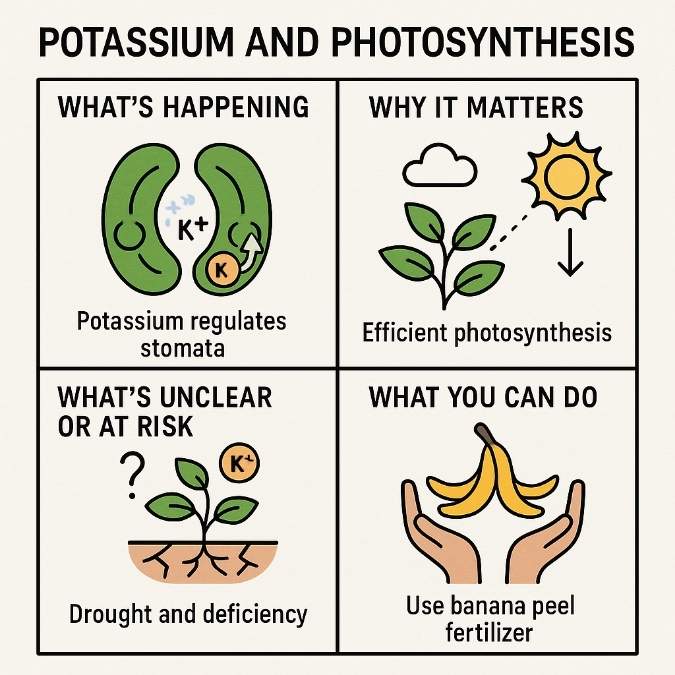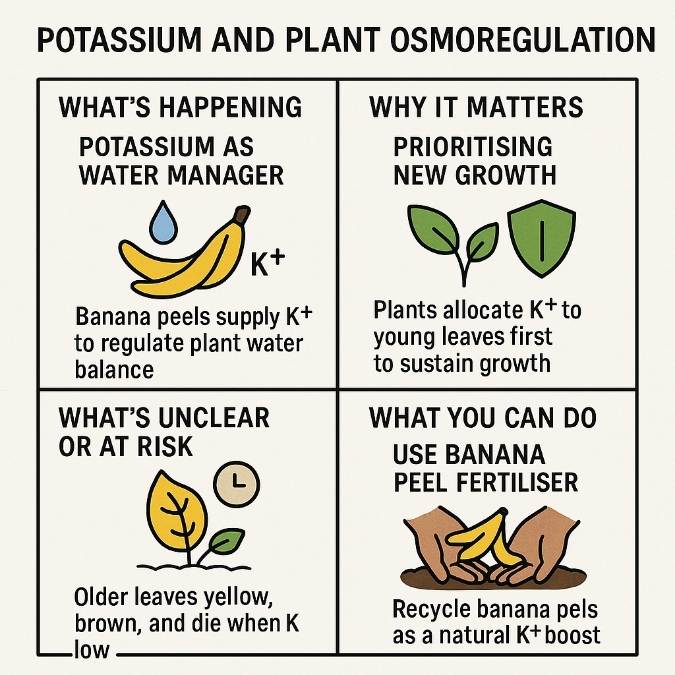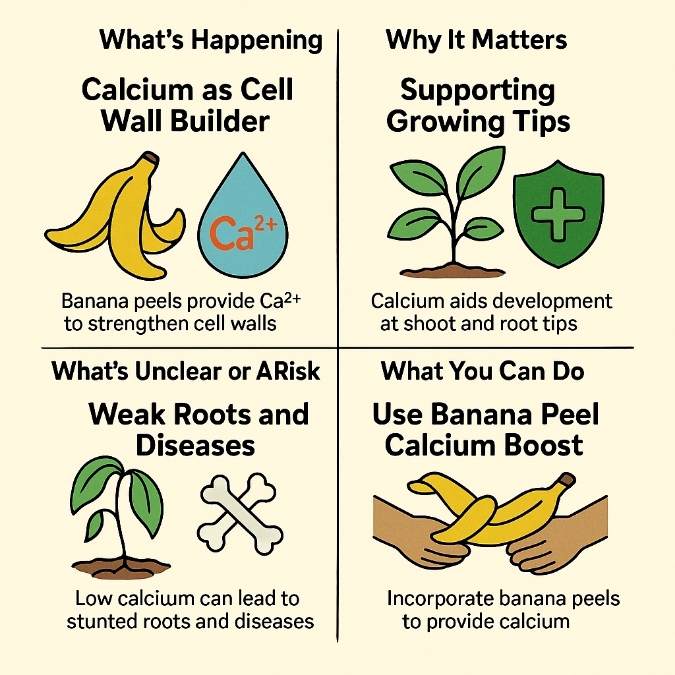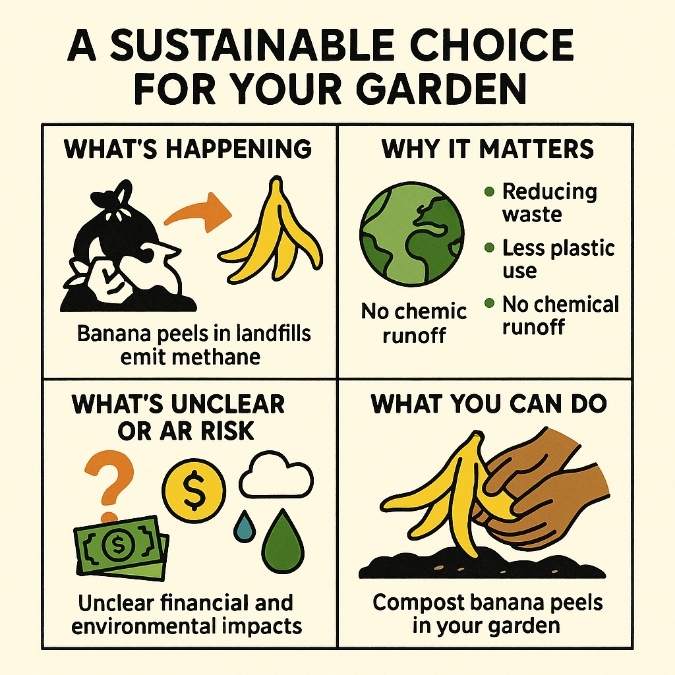Don't Throw Away Those Peels! 5 Reasons They're Great for Your Garden

Banana peels offer a sustainable and effortless solution to plant fertilisation. Full of elements like potassium, calcium, and iron, Banana peels play a crucial role in various plant processes, from photosynthesis to disease resistance.
| Benefit | Description |
|---|---|
| Enhances photosynthesis, aids water balance in cells, and supports overall plant growth. Nutrient Content: | |
| Increases turgor pressure, contributing to thicker and more upright stems. Structural Support: | |
| Regulates enzyme activity, improving the plant's ability to resist diseases. Protection Level: | |
| Ensures extended and uniform growth by slowly releasing nutrients over 6 to 8 weeks. Release Duration: | |
| Contributes to the zero-waste movement by utilising waste as fertiliser. Eco-Friendliness: |
Ever heard of the use of banana peels as natural fertilizer to plants? There’s science behind it and this sustainable solution won’t take much effort to do.
Known for their potassium content, bananas has essential nutrients (yes, not just one!) plants need. Banana peels, in particular, contain concentrations of potassium, calcium, sodium, iron, bromine, manganese, strontium, niobium and zirconium.
1. Potassium and Photosynthesis
Potassium is an essential nutrient that impacts nearly every aspect of plant health. From enabling photosynthesis through tiny leaf pores to strengthening stems and defending against disease, this unassuming element is a true workhorse for plants. One convenient way gardeners add potassium naturally is by using banana peels as fertilizer. Below, we'll explore how potassium works in photosynthesis (especially via stomatal regulation), why potassium matters for overall plant health, how banana peels stack up as a potassium source, signs of potassium deficiency to watch for, and practical tips to turn banana peels into a plant-boosting fertilizer.
Potassium plays a critical role in photosynthesis by controlling the opening and closing of stomata—the microscopic pores on leaves that allow plants to "breathe." Stomata must open to let in carbon dioxide (CO₂) for photosynthesis and close to reduce water loss. Potassium is the key that turns this mechanism.

Guard cells, which flank each stomatal pore, pump potassium ions in and out to change their turgor pressure. When guard cells take up potassium, they swell with water and open the stoma, allowing CO₂ to flow in for photosynthesis. Later, if the plant needs to conserve water—such as during drought stress—potassium is pumped out of the guard cells, causing them to become flaccid and closing the stoma tightly to limit evaporation.
In this way, adequate potassium helps plants strike a balance: keeping stomata open for photosynthetic gas exchange under favourable conditions while closing them promptly to prevent excessive water loss. Without enough potassium, stomata can't function properly, leading to reduced CO₂ intake, which hinders photosynthesis, or inadvertent water loss. In short, potassium is the behind-the-scenes regulator that ensures plants get the CO₂ they need for sugar production while minimizing dehydration.
2. Potassium and Plant Osmoregulation
Banana peels have lots of potassium, which helps plants control water. Think of potassium as a plant's water manager.
When a plant doesn't have enough potassium, it makes tough choices. The plant will move whatever potassium it has to the new, young leaves first. It's like a family with limited food giving the most to the youngest children. The plant does this so new growth can continue, but it comes at a cost - the older leaves get less potassium. These older leaves will start to turn yellow, then brown, and eventually die.
Potassium does several important water-related jobs in plants:
- Cell Expansion: Potassium helps cells fill with water and expand. This is how plants grow bigger! When cells expand, leaves get larger, stems grow taller, and the whole plant increases in size.
- Water Uptake: Roots need potassium to absorb water from the soil effectively. With enough potassium, roots can pull water up through the plant like drinking through a straw. Without enough potassium, this process weakens.
- Root Growth: Potassium helps roots grow longer and develop more branches. Scientists have found that plants low on potassium have shorter roots that don't grow as quickly. Stronger, longer roots help plants find more water and nutrients in the soil.
- Drought Protection: When water is scarce, plants with plenty of potassium can use the water they have more efficiently. They're better at surviving dry periods.

You can spot potassium-hungry plants by looking for yellow or brown edges on older leaves, weak stems that might flop over, and slow growth. These plants also tend to wilt easily on hot days because they can't manage their water properly.
3. Banana Peels for Strong Stems
Banana peels help plants grow strong, upright stems. When you add banana peels to your garden, you're giving plants two important minerals they need for strength: potassium and calcium.
How Potassium Strengthens Stems
Think of plant stems like water balloons. Potassium helps move water into plant cells, making them swell up and become firm - just like filling a balloon with water makes it firm. Scientists call this "turgor pressure." According to research from the University of Massachusetts Extension, potassium is essential for maintaining this cell pressure.
- Firm Cells = Strong Plants: When all the cells in a stem are filled with water, the whole stem stands up straight and strong. This is why well-watered plants with plenty of potassium stand tall, while thirsty plants often droop.
- Flexible but Strong: The right amount of potassium helps plants be both strong and flexible. This is important when wind blows - plants need to bend without breaking. Research published in the Journal of Plant Physiology confirms potassium's role in plant cell elasticity.
- Support for Heavy Fruits and Flowers: Plants with strong stems can hold up heavy fruits, flowers, or seed heads without falling over. This is especially important for plants like tomatoes and sunflowers. The Royal Horticultural Society recommends potassium-rich fertilizers for fruit-bearing plants.
How Calcium from Banana Peels Builds Better Plant Structures
Calcium works differently from potassium but is just as important:
- Cell Wall Builder: Calcium is like the cement that helps build strong cell walls. These walls give plants their structure and strength. Research from Cornell University shows calcium is crucial for cell wall formation.
- Growth Point Helper: Calcium especially helps the parts of plants that are growing quickly, like the tips of stems and roots. Studies from the American Society for Horticultural Science demonstrate calcium's importance in growing tissues.
- Root Development: Strong roots need calcium to grow properly. Better roots mean the plant can gather more water and nutrients from the soil. The University of California Agriculture and Natural Resources confirms calcium's role in root health.
- Disease Fighter: Calcium strengthens cell walls, making it harder for diseases to break into plant tissues. Research in Plant Pathology has shown that calcium can help reduce certain plant diseases.

By adding banana peels to your soil, you're giving plants both potassium for water pressure inside cells and calcium for stronger cell walls. It's like providing both the air for the tires and the strong frame for a bicycle - together they create a sturdy, well-supported plant that can grow taller without flopping over. A study in the Journal of Plant Nutrition demonstrates how these minerals work together for plant structural integrity.
4. Potassium and Disease Resistance
Potassium works like a plant's immune system booster. Just as a healthy diet helps us fight off colds, potassium helps plants fight off diseases. Research from the American Phytopathological Society shows that potassium is one of the most important nutrients for plant disease protection.
How Potassium Helps Plants Stay Healthy
- Guards Plant Doors: Potassium helps control tiny openings in leaves and stems. When these openings work properly, they can close quickly when harmful fungi or bacteria try to enter, just like you would close your windows during a dust storm.
- Strengthens Cell Walls: Plants with enough potassium build stronger cell walls. Think of it like building a house with brick instead of paper - it's much harder for diseases to break through.
- Keeps Nutrients Moving: Potassium helps plants move water, nutrients, and sugars throughout their tissues. Studies from the University of Florida show that this free movement of nutrients is crucial for plant health. It's like having clear roads for food deliveries instead of blocked traffic - everything gets where it needs to go.
- Controls Helpful Enzymes: Potassium activates over 60 different enzymes (special proteins) in plants. These enzymes are like tiny factory workers that help plants build what they need and break down what they don't. With enough potassium, all these workers can do their jobs properly.
- Reduces Plant Stress: Plants with good potassium levels are less stressed overall. Just like how a well-rested person is less likely to get sick, less-stressed plants are better at fighting off diseases.
What Happens When Plants Don't Get Enough Potassium
Plants without enough potassium often show these signs of poor health:
- Yellow or brown spots on leaves, especially older ones
- Curled leaf edges that look burned
- Stems that break easily
- More damage from insects (bugs seem to prefer potassium-starved plants!)
- Visible fungal or bacterial infections
By adding banana peels to your garden soil, you're helping your plants build their natural defence systems. The potassium in the peels helps plants stand strong against diseases that might otherwise take hold. This means fewer sick plants and less need for chemical treatments - all from something you might otherwise throw away!
5. Balanced Slow-Release Fertiliser
Banana peels are nature's time-release plant food. Unlike chemical fertilisers that dump nutrients all at once, banana peels break down slowly over time. Research from the International Journal of Recycling of Organic Waste in Agriculture shows that organic materials like banana peels release nutrients gradually as they decompose.

Why Slow-Release Nutrients Are Better for Plants
Think about the difference between eating one huge meal once a week versus eating regular smaller meals each day. Plants, like people, do better with steady nutrition rather than feast-or-famine cycles.
- Steady Feeding Schedule: As banana peels break down, they release nutrients little by little over 6-8 weeks. This means plants get a consistent supply of food rather than too much at once.
- No Burning or Root Damage: Chemical fertilisers can sometimes "burn" plants by giving them too many nutrients at once. Banana peels don't do this because they release nutrients slowly.
- Less Waste: When you apply too much fertiliser at once, much of it can wash away before plants use it. Slow-release nutrients stay in the soil longer, so more ends up in your plants instead of in runoff water.
- Less Work for You: Because banana peel fertiliser lasts for up to two months, you don't need to fertilise as often. Less work, same benefits!
How to Use Banana Peels as Fertiliser
According to studies from the University of Wisconsin-Madison, there are several effective ways to use fruit waste like banana peels in your garden:
- Bury Them: Cut peels into small pieces and bury them 1-2 inches deep near your plants.
- Make a "Tea": Soak chopped peels in water for 1-3 days, then water your plants with the nutrient-rich liquid.
- Dry and Crush: Dry peels completely, then grind them into a powder to sprinkle around plants.
- Compost Them: Add banana peels to your compost pile where they'll break down with other materials.
- Blender Method: For fastest results, blend peels with water and apply directly to soil.
| Benefit | Banana Peels | Chemical Fertilizers |
|---|---|---|
| Root Health | High | Medium |
| Environmental Impact | Positive | Negative |
| Nutrient Balance | Natural ratio | Artificial ratio |
| Cost | Free | Expensive |
| Release Duration | 6-8 weeks | 1-2 weeks |
A Sustainable Choice for Your Garden
Using banana peels as fertiliser is not just good for your plants—it's good for the planet too. Each year, millions of tons of food waste end up in landfills. When banana peels decompose in landfills, they release methane, a harmful greenhouse gas.
By putting those peels to work in your garden, you're:
- Reducing landfill waste
- Cutting down on plastic fertiliser packaging
- Avoiding chemical runoff that can harm local waterways
- Creating healthier soil that captures more carbon from the air
- Saving money on store-bought fertilisers

Banana peels transform from waste into a valuable resource that nourishes your plants, improves your soil, and helps the environment. It's a small step toward sustainability that makes a real difference in your garden—proving that sometimes the best solutions are simple ones we might otherwise throw away.
Hi all. I just wanted to let you know that the team and I at Lily's Florist made some, well a load, of updates to this article. To be really honest, the original was just nowhere near good enough. The original article was published on 11.3.21 and almost 4 years to the day we gave it a massive overhaul. We added the following:
- Some infographics and visualisations
- We expanded on the 5 topics and far more detail but made it far easier to understand
- Anything we wrote or quoted has now been referenced, we are not scientists after all, not by a long shot :)
